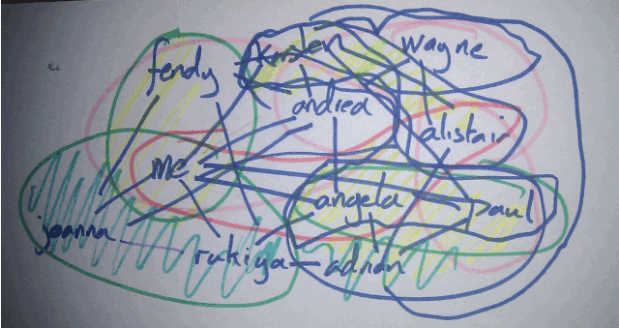What does your company’s organisational chart look like?
a) the Eiffel Tower,
b) a bowl of spaghetti?
SuccessFactors Professional Edition – a thought provoking trial
I’ve been trying out the SuccessFactors Professional Edition (SMB market) software recently (and no, this is not a review of it, that’s coming later (maybe).) It gave me a moment’s pause to think. Does the organisational structure at my company actually resemble a tree (an upside down one I guess) at all? The SuccessFactors software has a great organisational structure visualisation tool (far nicer than the Nakisa one IMNSHO), but it’s all about visualising a traditional hierarchical organisational structure.
Different types of structures
At the same time I was thinking about this, I happened to read the supposed “Valve Handbook for New Employees“. On page 4 (I’ve included the link, if you haven’t read it, I can recommend it, fascinating stuff and far more than just the bit I’m talking about here) it describes the structure of the organisation.

It makes a point:
“Hierarchy is great for maintaining predictability and repeatability. It simplifies planning and makes it easier to control a large group of people from the top down, which is why military organizations rely on it so heavily.”
Like Valve, I don’t see the organisation that I work for being particularly militaristic. I grew up as an “army brat” and therefore have a very healthy (in my eyes) disregard for any kind of imposed authority. Someone telling me that I must do something in a certain way, is almost a guarantee that I’ll try to find a different way of doing it. I try to treat the people I work with like I would like to be treated. Telling someone to do something is pointless, explaining to them why they should do something – that’s more like it.
I’ll digress from my main point here for a little bit, because a random memory has just sparked, and it’s sort of relevant. When I was a new grad starting out in the big wide world of SAP HR consulting all those years ago, my boss at the time hauled me out of the clients where I was shadowing and learning, and into the office. For one week I helped the office admin team file expense reports, collate time sheets and put together invoices After that, although I may never have been the best at getting my expenses in on time, when they did get in, they were very clearly and neatly arranged. Why? because I had learnt that doing so was a simple task for me, but made the life of the admin person so much easier. Because someone had taken the time to show me why I should do something in a certain manner, I was very happy to do it.
Hierarchy and innovation, not great mates
In their employee handbook Valve go on to say:
“But when you’re an entertainment company that’s spent the last decade going out of its way to recruit the most intelligent, innovative, talented people on Earth, telling them to sit at a desk and do what they’re told obliterates 99 percent of their value. We want innovators, and that means maintaining an environment where they’ll flourish.”
I’ll put my hand up right now and admit that Discovery is not an entertainment company, despite it sometimes being very entertaining to work here, yet I’ll completely agree with the sentiment of it being an absolute innovation killer to tell people exactly what they must and must not do. To me to provide the sort of environment that people are going to thrive in means everyone having a say and everyone moving forward.
Such a dynamic (yes my description and substitute whatever smanky term you want to use instead) way of doing things cannot, I believe, have a non-dynamic organisational backbone.
So let me try to put that on paper for you
I tried to draw a simple map of the relationships between a few of the employees in our company (disclaimer, I didn’t stop to think too long about who is linked to who very hard here, so if you’re on this chart and I didn’t link you correctly, sorry, it isn’t a real org chart because there wasn’t a whiteboard involved.)

when I tried to add just one more employee (Karsten) it just got far too messy:

My point is, that as a small company, we just don’t fit into the traditional hierarchical organisational structure. And to follow on from the point made by Valve, I don’t think it is in the best interests of our organisation or staff that we do.
Scientific interlude to counter excess HR fluffiness
Another digression (sorry) even evolution (Darwin’s tree of life) isn’t consider a tree these days, it has been recognised that due to the transfer of genetic information from and through viruses and bacteria there is an awful lot of our genome that doesn’t come from our direct ancestors, but from other species. It’s called horizontal gene transfer (HGT) and has been found to play a major role in forming species. To use this analogously, I should suggest that who you are working with, who influences you and who you influence are more important to who you are than the person that you supposedly report to.
Back to HR (or HCM, or whatever…)
Now I don’t think that either Discovery or Valve (or Dawin’s web(?) of life) are unique in this. I think the days of the hierarchy are numbered, and what is more, we are inventing and deploying the tools right now that will be its undoing.
Tooling up for the revolution
Enterprise social networking, whether using tools like Jam, Streamwork, Yammer, Google+ (we use this a LOT internally, it’s free, simple and powerful!) or even going more external with tools like Twitter, LinkedIn, and, so help you, Facebook is clearly in vogue. It should be a simple matter to leverage these tools (along with email ) to find out who is talking to who. From this we would have a clearer picture of who is talking to who, how often and in what formats. We could use this data to help us consult the right people. We already do this in many ways, but imagine having a system that could help us. In the same sort of way that GMail prompts you to include certain people in an email based on your past emails but that would also check the content of your message (I know this sound horrendous to some of you, but I’m just imagining stuff here, not planning for an actual solution, bear with me). The possibilities of how we could capture and utilise the connections between our employees to add value to the business are only just starting to be explored.
I’d push the analogy that I’m trying to make so far as to say that communities of interest are the new org units of enterprise. Although you might not send a leave request to be approved by your local ketchup appreciation group (I used to read the USENET alt.ketchup group at uni for a laugh, how the world has changed! I can’t even find a link to it now.) You are more likely to check that your vacation isn’t going to leave the project teams you are working with in the lurch, rather than checking with the team with whom you are theoretically assigned but haven’t worked with for the last 6 months.
When it comes to handling career goal planning, I think that we need to be encouraging everyone to be part of the process. (I happen to agree with Prof. Culbert about the usefulness of performance reviews, but strongly believe that goal setting is a great way to understand how to get to the next level, in a positive way.) 360 type reviews (where we reference and review with the people we are working with, rather than an arbitary “manager”) of the goals that we are setting allow ourselves allows us to help ourselves and our teams understand where are heading, without the soul-sucking negativity associated with most performance reviews. For such a distributed process, there is no benefit to a rigid structure where person A conducts the review for person B, C and D. Again I see great potential in the use of social communication tools to share and organise and optimise these processes.
Full circle
So back to my original musing, what does my organisation look like? I don’t think I know yet, but I think it’s going to be fluid. If I want to be part of a successful innovative company (and who doesn’t) I think it need to be able to change shape depending on how and why I’m looking. And my view of the organisation should be able to change that shape without me needing spend days of constant restructuring.
And to finally relate that to something SAP
Returning to my thoughts about the SuccessFactors Professional Edition product and its use of strict hierarchical structures. I don’t think that these do fit with how many SMB companies are choosing to operate today. Yet, I can see how a SaaS solution that is planning to integrate “social” into everything they do (one of the strong messages from SuccessConnect) will possibly get me there a lot quicker than an onPremise solution will. I hope that by posting this up people will read this and start to think about how we can start to leverage the tooling that SAP is providing to be more creative, dynamic and successful. SuccessFactors people, you have a real opportunity to create something in this space, please let’s build something awesome.
As per always, these are my own personal views, and do not necessarily represent those of the company I work for. I purposely take a line which is at times controversial and contrary to many people’s beliefs. I don’t think I’m correct, it’s just that no-one has convinced me otherwise yet. This blog was originally published at http://scn.sap.com/community/erp/hcm/blog/2012/07/09/my-organisation-looks-like but I thought it really ought to be here too. Partly inspired by Vijay’s blog about talent being unmanageable, and my thoughts on what does that mean about talent being managers. What I’d want to point out is that I see a future coming where out HRIS system may mean the end of people managers as we know then – thus solving the conundrum of how do we manage talent and/or should talent be managers.
References: in a list to make life easier for you
Valve Handbook for New Employees
http://www.successfactors.com/small-business/professional-edition/overview/
http://www.scribd.com/doc/90526695/Valve-Handbook-for-New-Employees
http://www.quora.com/Social-Media/What-is-a-Smanker (my own adaption)
http://www.newscientist.com/article/mg20126921.600-why-darwin-was-wrong-about-the-tree-of-life.html?full=true
http://www.newscientist.com/article/mg20126923.000-editorial-uprooting-darwins-tree.html
http://mashable.com/2012/06/24/social-media-workplace-study/,
http://apcmag.com/why-social-media-in-the-workplace-is-not-the-enemy-business-benefits-of-staff-usage-.htm
http://byresearch.wordpress.com/
http://gmailblog.blogspot.com.au/2011/04/dont-forget-bob-and-got-wrong-bob.html
http://english.stackexchange.com/questions/1269/is-it-bear-or-bare-with-me
http://en.wikipedia.org/wiki/Community_of_interest
http://www.nytimes.com/2011/03/02/opinion/02culbert.html?_r=1









